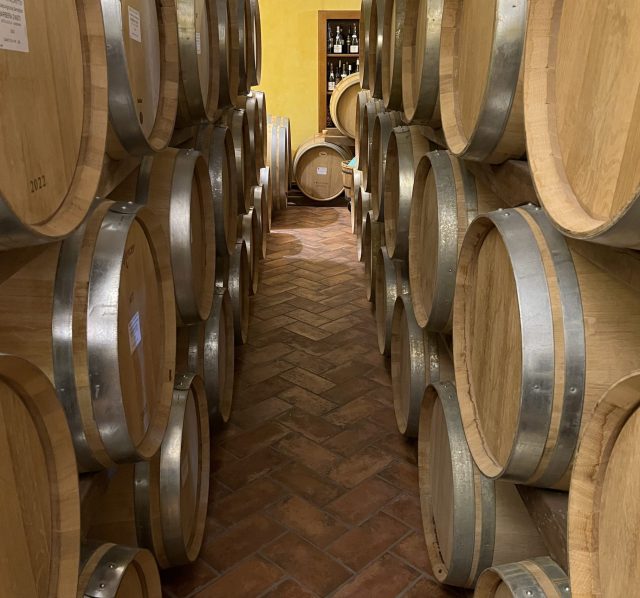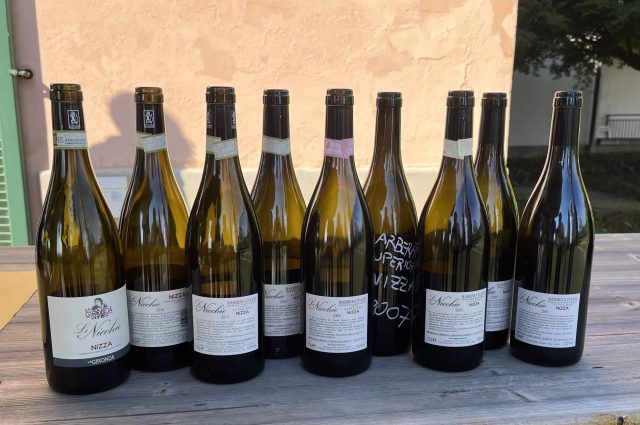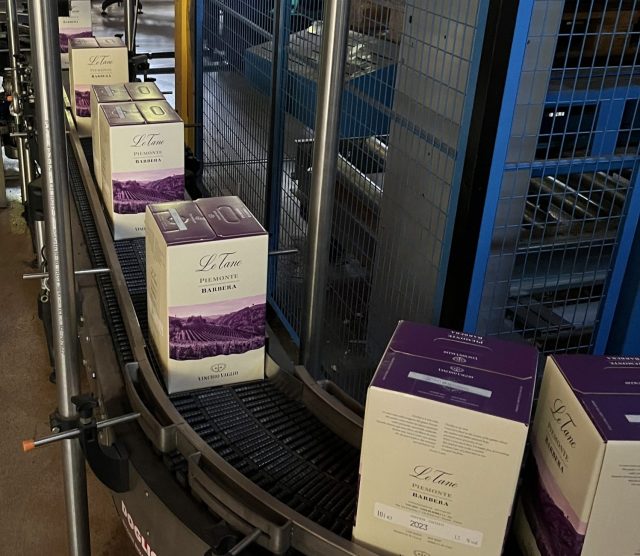Monferrato’s modernisation of Barbera: Part One
Louis Thomas travels across Monferrato to explore how Piemonte’s most-planted grape variety is ripe for innovation.

The first record of this grape variety dates back to the 13th century, and, 800 years on, it is still going strong. Overall, 16 Piemontese DOCs/DOCGs permit Barbera, and it makes up around a third (31% as of 2022) of the 40,000-plus hectares of vineyard planted in this north-western corner of Italy.
The area of Monferrato, surrounding the commune of Asti in the south of Piemonte, is Barbera’s home turf. Once the bed of a prehistoric sea, the region’s soils are rich in calcareous material and other marine sediment.
Barbera’s key features as a grape variety are very high acidity, relatively low tannins, and high levels of anthocyanins, giving it a depth of colour closer to that of Montepulciano or Syrah than other Piemontese grapes like Nebbiolo and Grignolino.
These attributes make it an excellent accompaniment to food, but, although alcoholic expressions of the grape created entirely in stainless steel can fit the bill as a simple, pleasant table wine, the right oak regime can also work wonders.
Giving it both barrels

The big Barbera winemaking innovation has been the post-Parker lurch away from maturation in smaller oak vessels to larger ones.
Many producers espoused the mantra of what they want the drinker to experience in the glass: “Barbera first, oak second.”
Oak still plays a vital role in enhancing the wine. As Marchesi Incisa della Rocchetta managing director Filiberto Massone Incisa della Rocchetta put it: “What we look for in wine is complexity, longevity and depth – without the use of oak, the wine doesn’t last long in the bottle: it’s a simpler wine than what it can become.”
But tastes have changed in recent decades, and consumers don’t necessarily want to taste vanilla, cloves and cedar before they taste any fruit.
“Stylistically we don’t want we don’t to overwhelm the wine with too much oak, otherwise we’d be making carpenter wines – then we might as well be using oak chips,” Della Rocchetta joked.
“Each barrel can cost around €800, so it’s a big investment, but the big casks do last longer, and they are softer for the wine,” he shared. “Barriques are like a powerful chemical reactor, also in terms of micro-oxygenation.”
Producers are known to ‘shave’ the insides of large botti to prolong their lifespans, exposing the wine inside to a fresh layer of wood.
Sometimes accelerated micro-oxygenation is desired. One producer, who shall not be named, revealed that for one of their wines, a small amount of oxygen is pumped into the stainless steel vessel to mimic the structural consequences of time in oak, with none of the flavour – other producers mature their Barbera in concrete to achieve a similar effect over a longer period of time.
Of course, this is not to say that producers are abandoning barriques for Barbera – most still tactically employ them.
Il Falchetto’s Lurei Barbera d’Asti Superiore DOCG is in keeping with the ‘new classic’ style, being aged in 15-20-year-old Slavonian oak botti. Winemaker Margherita Forno said that when used like this, the vessel is comparable to a “wooden container for the wine”: “The oxygen helps to fix colours and flavours, but the wine stays smooth and fruity.”
By contrast, Il Falchetto’s Bricco Paradiso, also a Barbera d’Asti Superiore DOCG, is aged for 12-14 months in 225 litre French barriques to give it a more “rustic” quality. Its Bricco Roche, a Nizza Riserva DOCG spent around 30 months ageing 70% new and 30% one-year-old barriques creating a “rich and very complex” wine “with the potential to age for 25 years, maybe even more”.
Though certainly true that the current fashion is a return to the more traditional maturation vessel of big botti, especially those made by Gamba in Asti, smaller barrels still have a role to play. The wines they produce may seem out of touch with modern palates due to their ‘heavier’ nature, but they offer something very necessary in the wine world: a point of difference.
Waiting game

When it comes to fine wine, Barbera is overshadowed by Nebbiolo, the grape that gives us Barolo and Barbaresco, and it is certainly fair to say that most of the Barbera-based wines of Monferrato are produced with the intention of early drinking. But, don’t be fooled into thinking that Barbera cannot stand up to prolonged periods in the bottle – the very same attribute that makes it an excellent gastronomic wine, its high acidity, also helps it to age. The colour, thanks to such an intensity of anthocyanins, also holds fairly well.
Partner Content
With 11ha of vines in the heart of Nizza DOCG, La Gironda is a fairly new arrival, founded in 2000 – meaning that a vertical tasting of vintages of its 100% Barbera Le Nicchie (meaning ‘The Niche’) going from 2020 back to 2001 offers a good overview of the estate’s story.
“2020 is still young, but it has aged for four years, so we need to put it on the market now,” explained Susanna Galandrino before guiding us through almost two decades of Le Nicchie.
Tasting backwards, through the “very hot” 2013 (the “freshness” of which “surprised” Galandrino) and the “also very hot” 2007 (which she thought would be “ready to drink once it was off the skins and would never age well” but has proved that early pessimism wrong), it is clear that this is a grape that should not be underestimated.
I would say that tasting the “more evolved” 2005 and 2001 vintages (the latter being from the same year as Galandrino’s son, Paolo), it seems that the wines are bordering on tired, losing most of their primary fruit and becoming dominated by leather and liquorice, though with just enough life left in them to still be enjoyable.
The winemaking has remained largely consistent – ageing for 12 months in French oak and a further 12 in bottle – but growing conditions have not.
“The recent vintages are around 15.5% ABV,” shared Galandrino, “but 2007 and 2009 are around 14.5%, because of global warming.”
“We have to respect the laws,” she continued, “and the only way to reduce the alcohol is to leave more grapes on the vine, which reduces the quantity of sugar in the bunches, but the maximum yield is seven tonnes per hectare, so we have to cut the bunches, and those that remain on the vine get more concentration of sugar, and therefore more alcohol.”
Fortunately, that signature Barbera freshness keeps things in balance, even as ABVs climb.
“Because of Barbera’s acidity, you don’t feel it [alcohol] too much, but you have to serve it as the right temperature. If it’s too warm, you notice the alcohol more.”
It isn’t just what’s in the bottle that has changed during this period – Nizza became a DOCG in 2014, so prior vintages were labelled as Barbera d’Asti Superiore Nizza (though the production regulations were the same).
Not all Barbera should be aged, but the potential is clearly there, and producers willing to hold onto bottles could offer something a little bit more unexpected than just the fresh and fruity style that is so dominant, while still playing to the grape’s strengths.
In the bag

Some of the larger wine businesses in Monferrato are going big when it comes to alternative packaging for Barbera.
Vinchio Vaglio, a co-operative founded in 1959 with 19 winegrowers (so named because of its position between the villages of Vinchio and Vaglio Serra) has mushroomed into one with almost 200, covering more than 500 hectares, 70% of which is planted with Barbera. Each year it produces around one million bottles and 700,000 bag-in-box, and it has its own filling lines for both.
With the latter, it offers a three litre format, popular with everyday consumers, and a 10l bag-in-box, which is aimed at restaurants wishing to offer a Barbera by-the-glass.
“For us it wasn’t a sustainability choice at first,” revealed export manager Tessa Donnadieu. “In 2008, because of the financial crisis, people were very sensitive to costs, so we needed to keep our market share. In 2009, we bough the bag-in-box bottling line, and the demand exploded, so it has been very helpful. It was a very good idea to invest in it: two-thirds of our production [by volume of wine] is is bag-in-box – getting Equalitas certification last year was easy because of it!”
The bag-in-box has certainly proved to be a hit domestically, with 40% of Vinchio Vaglio’s domestic sales (which make up 85% overall) being to restaurants, but Norwegian and Japanese customers have also reportedly taken to buying bag-in-box Barbera.
“Barbera could be the next Sangiovese,” argued Donnadieu. “You can enjoy a young Chianti, you can enjoy an easy-drinking, fresh, stainless steel Barbera, and for not too much money.”
These attributes making Barbera-based wines excellent for restaurants seeking something to serve by-the-glass, and large format bag-in-box seems to be ideally suited to that scenario.
The rise of bag-in-box Barbera is a reminder that there is innovation at the affordable base of the wine market, not just at the tip of the pricing pyramid.
Related news
Campari sells Averna and Zedda Piras, raising £88m




